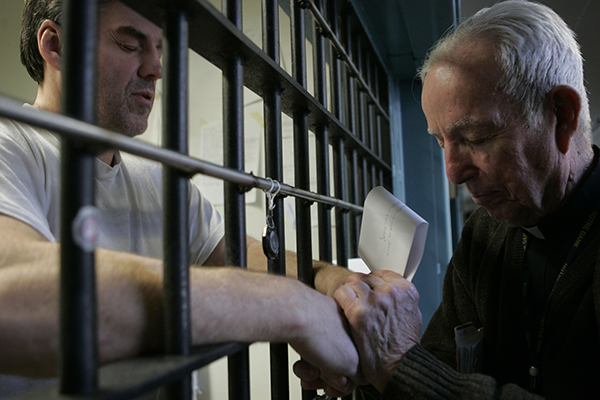
By Christopher White, National Correspondent
NEW YORK — When Chris Castillo’s mother was murdered in 1991 and a friend commented that if it had happened to him, he’d want seek revenge and kill the perpetrator, Castillo began to think deeply about the nature of crime and punishment.
“I realized that if went out and killed my mother’s killer, I’d be a murderer, too,” Castillo reflected.
Now, nearly thirty years later, Castillo has become an advocate for restorative justice — an approach to criminal justice that engages both the victim and the offender and is more focused on repair than on retribution. He told The Tablet that the practice “changed my life.”
“It healed my heart and turned me into a different person” and, for Castillo, is an obvious extension of his Catholic faith.
April 19-25 marked National Crime Victims’ Rights Week, an annual event meant to honor crime victims and their families, and for some Catholics it was an opportunity to raise awareness of the healing role restorative justice can offer in the criminal justice process.
Krisanne Vaillancourt Murphy, executive director of Catholic Mobilizing Network Against the Death Penalty (CMN), told The Tablet that “the aims of National Crime Victims’ Rights Week and restorative justice complement one another.”
“Both lift up the voices, needs, and inviolable dignity of victims/survivors of harm,” she said. “For CMN, such victim-centered approaches to crime are integral to our vision for a criminal legal system that heals rather than punishes.”
Restorative justice began to develop from a theory into actual practice in the 1990’s, where it is now a full-on movement with the support of law enforcement, teachers, lawyers, judges, and victims — yet despite serious buy-in from key sectors of society, the practice remains largely unknown in most communities.
The process, by all accounts, is emotionally intense, where the survivor of a crime meets with offenders and, often, other members of the community. There, the victim/survivors have an opportunity to detail their own suffering and loss and to seek understanding as to why a crime occurred. The offender also has an opportunity to speak and to explain what happened — and, in many cases, to seek forgiveness.
When Kate Grosmaire’s 19-year-old daughter Ann was shot and killed by her boyfriend, Conor, in 2010, Kate and her husband Andy, a deacon in the Diocese of Pensacola–Tallahassee, Florida, opted for a restorative justice approach — in part because it was a way the couple could get answers to questions that haunted them about their daughter’s death.
“Restorative justice, from a victims perspective, gives you such a great opportunity to be involved in the process, to have your voice heard, and also to get questions answered,” Grosmaire told The Tablet, adding that it was especially important to her husband to be able to ask Conor the questions that he otherwise would have never had answered.
“This can bring a sense of peace by getting an answer to questions,” she said.
Grosmaire, who would later recount her own journey in a book, “Forgiving My Daughter’s Killer – A True Story of Loss, Faith, and Unexpected Grace,” further emphasized that it allowed their family to dialogue with criminal justice officials so that Conor’s sentence was not merely a punitive sentence, but a meaningful one.
Most importantly, it created the conditions for forgiveness, and to this day, Conor remains a part of their extended family.
Both Castillo and Grosmaire agree that restorative justice is a natural fit for Catholics and today they both spend much of their lives advocating for the practice.
“It pulls the scales from your eyes and reminds you that we’re all sinners,” said Castillo, who is a volunteer for the organization Bridges to Life where he runs a weekly restorative justice program for prisoners. “You see a lot of similarities between yourself and the perpetrators. We’re all guilty of sinning.”
“When you hear it defined, you can see why Catholics are all about restorative justice,” Grosmaire said, while also acknowledging that it’s an uphill battle in a society that reflexively wants clear cut solutions and defined standards for what “justice” should look like.
“The traditional criminal justice system is just so ingrained in our everyday lives,” Grosmaire told The Tablet. “We are more likely to see a ten-year-old arrested for stealing a bike or getting into a fight with a fellow student than we are to see them bring brought into a restorative justice circle.”
She said that she’d like to see it applied to smaller problems, such as in schools or interpersonal conflicts, so that “it won’t seem such a foreign concept to have it in the criminal justice system or in our churches.”
For that reason, both Castillo and Grosmaire both think education is a huge part of the work that remains and that’s why both have partnered with CMN, which has engaged in restorative justice initiatives as an extension of their work to bring about the end of the death penalty.
“Restorative justice offers concrete ways to honor the dignity of all those impacted by harm or crime, namely through its commitment to include the voices of victims/survivors, perpetrators, as well as the families and communities of each in the process of addressing the harm,” Vaillancourt Murphy told The Tablet.
“In many ways, our modern criminal legal system prioritizes punishing the person who is guilty, with little to no regard for the actual individuals and communities that were harmed,” she continued. “Taking a restorative justice approach allows us to imagine and enact responses to harm that foster hope and healing for all those impacted and creates the possibility of making amends.”
“When we think about our incarcerated brothers and sisters, we see time and time again that ‘hurt people hurt people,’ she concluded. “Restorative practices can create safe spaces for trauma healing that help to interrupt cycles of violence and incarceration.”
